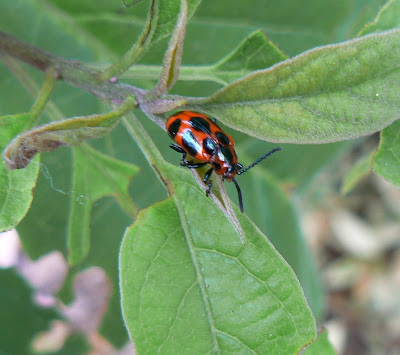
I am still having fun with my new camera and capturing all sorts of things which I had no hope of seeing before. There's a whole tiny world out there if we just look hard enough.
This is quite a tiny beetle, think ladybird size. Although when you see her you know she is not a ladybird, not with that shape. Ladybirds always make me think of the VW beetle, same little rounded shape, but I don't suppose I'm the first one to have had that thought. They are called VW Beetles after all.
The tell tale holes in the leaves gives a clue about the diet of this pretty beetle. I have been reliably informed she is a Leaf Eating Beetle but other than that I cannot name her.

Next up is a very small fly. I tried the obvious in the search engines "green and black banded fly" but that didn't work. It could have. After all if you type in "pink-bellied moth" it works - you get a hit. Maybe it isn't even a fly - I'm just assuming, but the more I look at her the more I think she looks mosquitoish, especially with those long legs.
She was really, really tiny, even minute, but I can't remember what type of leaf it was on. Drat. Now I am going to have to walk around with a notebook, or maybe better still a little tape recorder.
At least now I have a record of what I've seen - I don't have to try and remember while being confronted with lots of possibilities, which by the time I have looked at them all I have no hope of even remembering what the original insect looked like. It's been wiped from my brain.
I didn't fare any better with this metallic blue fly.

While I was searching I came across a website though which is really interesting. It seems to be one family's effort to study insects in their native area, (Brisbane, Australia) and their efforts are really impressive and scholarly.
Link
Here we have a very well camoflauged insect which I first took to be a moth. I had my doubts though because I thought I could see bug eyes, rather than antennae. It took me a while of searching through various books and in the end I found it quite by accident. It is in fact a Scolypopa australis or Passionvine Hopper and it is indeed a type of bug which sucks fluids from plants.
A book I really like is
Burnum Burnum's Wild Things which is a pocket sized book that you can take bushwalking with you. Its contents are organised in an unusual way, for example flowers are listed under their colour, so that if you come across a pink flower you just look in the pink/red flower section. By necessity it only has quite common things in it but nevertheless very useful.

Lastly is this little beetle, classic lady bird shape. There is a family of them living on my Zucchini plants. I have no idea if they are good guys or bad guys but I can't see any apparent damage so they are safe for the moment. Besides I have so many zucchinis I can share.






























